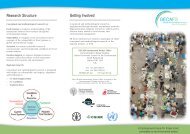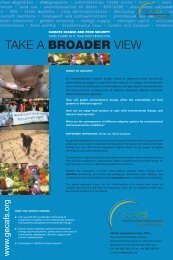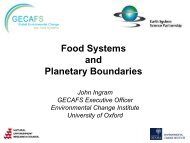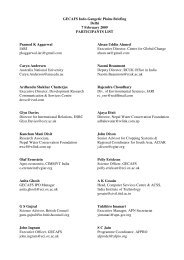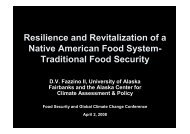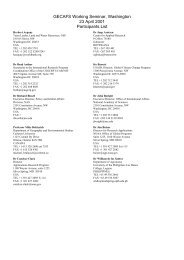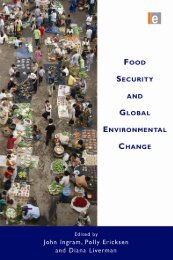From Food Production to Food Security - Global Environmental ...
From Food Production to Food Security - Global Environmental ...
From Food Production to Food Security - Global Environmental ...
- No tags were found...
You also want an ePaper? Increase the reach of your titles
YUMPU automatically turns print PDFs into web optimized ePapers that Google loves.
(iii) the ability for a policy interpretation of different future conditions (comparing graphs);and (iv) adaptation insights at the regional level for improving overall food security (where <strong>to</strong>concentrate effort on enlarging the polygon areas of each graph). They also brought <strong>to</strong>gethera wide range of specialists and representatives of the many stakeholders involved in foodsystems who hither<strong>to</strong> had not interacted. It should be noted, however, that the purpose ofthese initial scenario exercises was <strong>to</strong> investigate food security outcomes of plausible futures.They were not designed <strong>to</strong> determine adaptation pathways, which should form the subject offollow up research.Example 4: Quantifying the contribution of food system activities <strong>to</strong> crossing ‘planetaryboundaries’Many human activities affect environmental conditions, degradation of which will underminethe natural resource base upon which food systems are founded. This example discusses howfood system activities affects environment (the ‘feedback’; Figure 2), and is based on thenotion of ‘planetary boundaries’. These define the safe operating space for humanity withrespect <strong>to</strong> the Earth system and are associated with the planet’s biophysical subsystems orprocesses. If these thresholds are crossed, then important subsystems, such as a monsoonsystem, could shift in<strong>to</strong> a new state, often with deleterious or potentially even disastrousconsequences for humans (Rockström et al., 2009); Figure 4. Identifying and quantifying‘planetary boundaries’ that must not be transgressed therefore help prevent human activitiesfrom causing unacceptable environmental change.One of the most – perhaps the most – ubiqui<strong>to</strong>us human activity relates <strong>to</strong> striving <strong>to</strong> attainfood security and from a ‘food’ perspective agriculture is usually thought of as the cause forconcern; 12-14% of <strong>to</strong>tal greenhouse gas (GHG) emissions are attributed <strong>to</strong> agriculture and afurther 18% attributed <strong>to</strong> land-use change and forestry (much of which related <strong>to</strong> clearingland for agriculture and pasture) (Foresight, 2011). However, all food system activities lead<strong>to</strong> GHG emissions and Edwards et al. (2009) estimated that in the US food system, only 60%of GHG emissions can be attributed <strong>to</strong> producing food; 40 % are due <strong>to</strong> the other food systemactivities. But GHG emission is not the only environmental consequence of food systems.Impacts on biodiversity, on biogeochemical cycles, on fresh water resources and on otherenvironmental parameters are all in part caused by food system activities (Figure 2).Table 2 shows a matrix of the four sets of food system activities against eight of the 10planetary boundaries (‘ocean acidification’ and ‘stra<strong>to</strong>spheric ozone depletion’ are notincluded as they were not quantified).Rather than being confined <strong>to</strong> impacts of agriculture, Table 2 gives examples in almost allcells of the matrix; almost all food system activities contribute <strong>to</strong> ‘crossing the boundaries’.47



